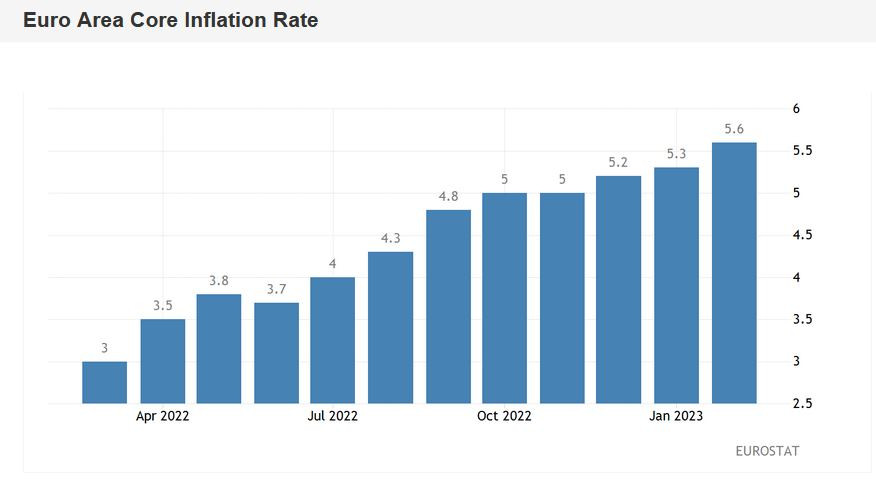
The eurozone inflation report was in the green zone: all components of the report were above forecasts. But the EUR/USD reacted to the report very peculiarly: instead of a bullish attack to the area of the 7th figure, the price moved down and fell under 1.0600. Such an unusual, at first glance, reaction is quite reasonable.

European Central Bank President Christine Lagarde stopped the upward momentum, as she "poured cold water" on the bulls. She reacted rather calmly to the report and did not answer the question about the further pace of rate hikes. The euro was under pressure, while the US Dollar Index soared up again, reacting to the hawkish comments of the Fed officials. As a result, the fact that the report was in the "green" did not help the bulls: and so the bears quickly took the initiative by pulling the price down to the base of the 6th figure.
The language of dry figures
Actually, the report was not sensational: certain signals were given when the German inflation growth figures for February were announced. The Consumer Price Index remained at the January level of 8.7% at an annual rate with the forecasted decline to 8.3%. On a monthly basis, the indicator exceeded the forecasted values, being at 0.8% (with the forecast of a decline to 0.4%). The annual harmonized consumer price index (HICP), which the ECB prefers to use to measure inflation, rose to 9.3% (after rising to 9.2% in January). All components of the German report exceeded forecasts.
German figures often correlate with Europe-wide figures (Germany accounts for about a quarter of all price data used to calculate inflation in the euro area), so it's not surprising that the report was also in the green zone.
Thus, the overall CPI in the eurozone came in at 8.5%, while most experts had expected a bigger drop, to 8.2%. At the same time, the core CPI demonstrated an uptrend at 5.6% (with the forecasted minimum drop to 5.2%, from the previous value of 5.3%).
The structure of the release indicates that growth of energy prices in the euro area slowed down to almost 14% in February (from the previous value of 18.9% in January), while the rise in prices for food, alcohol and tobacco products accelerated to 15% (in January it was 14.1%).
Lagarde's reaction
Despite the fact that the decline in general inflation in the eurozone has slowed down and core inflation has accelerated, the pair fell almost 100 points during the day. This is because of Lagarde, who didn't toughen her rhetoric in response to the high-profile report.
On the one hand, the ECB head said that the decline in price pressure in the eurozone "is not stable". On the other hand, she stressed that inflation should slow down "much more substantially" in March. At the same time, Lagarde was rather vague about the prospects for further monetary tightening. According to her, a rate hike at the March meeting "is very probable and necessary" (while the market estimates the probability of a 50-point hike in March at 100% already).

She acknowledged that the central bank will move toward tightening further, but did not specify the possible trajectory of this movement. Lagarde said the pace of future hikes was "impossible" to predict. Nor did she actually answer the other question about the final rate. When asked about what could be the rate cap within the current tightening cycle of monetary policy, the ECB head said that "would be decided by the economic data available at the time".
Conclusions
The subdued comments of the head of the ECB offset the hawkish mood of EUR/USD bulls. Regarding the 50 bps rate hike in March, it is now possible to speak about it as an accomplished fact - but the fact is that the market was initially confident in the realization of this scenario. While the further pace of monetary policy tightening remains unclear. As Lagarde's comments suggest, she is confident that eurozone inflation will slow down "more substantially" in March. The obvious conclusion is that the ECB will only tighten/soften its rhetoric based on the March inflation reports. The February report surprised, but it was not a catalyst for more hawkish sentiment - at least on the part of the ECB head.
From a technical perspective, the pair is in an uncertain situation. On the daily chart, the pair is between the middle and bottom lines of the Bollinger Bands indicator, also on the Tenkan-sen line and in the Kumo cloud. In my opinion, it would be better to consider short positions only after the price breaks through the support level of 1.0550 (the bottom line of the Bollinger Bands on the same chart), with 1.0500 and 1.0450 as the targets.